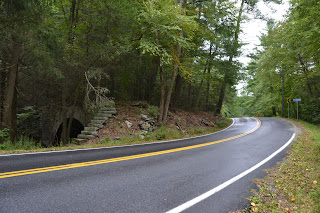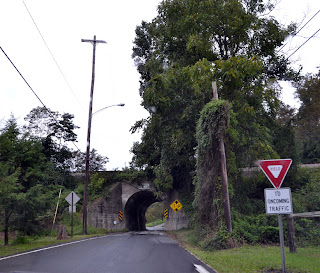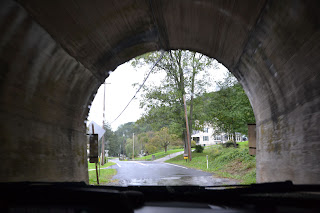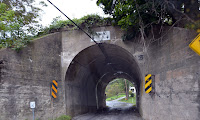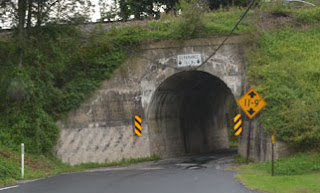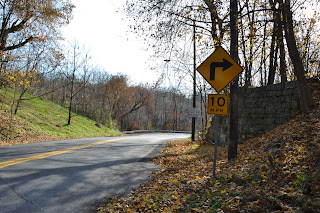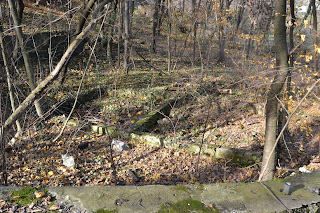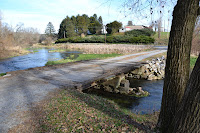What is 'bridge hunting'?
Bridge Hunting is a fun way to see the country side, but more importantly than seeing bridges connect towns to other towns, is to see how bridges were made when CAD didn't exist and concrete UCEB (ugly concrete bridges) weren't commonplace. It is going after what you think might be there based on Google or Bing Maps. It is finding a renown bridge that no one has documented in your circle. It is going back in time to experience what your ancestors did 75 years ago...100 years ago...125 years ago.
Do I need a license?
No. But do wear protection. I wear an orange safety vest when in higher traffic areas (and don't tell my mother, but I have a conceal carry permit and sometimes I carry a gun).
Do I get to eat what I kill?
Ahhh you must be from Pennsytuckey...and the answer is no. Please do not take anything from the locations you visit...and leave only footprints and slight ruts in the mud like CatHerder does cuz she's easily 5,000# after visiting McDonalds.
Is there a season for that?
I will tell you this:
- April and May are great because flowers are just starting to blossom, yet foliage is still minimal meaning you can see MORE of the bridge.
- October and November are great because the leaves are changing which adds vibrant colors. And in November you might see less colors and leaves and the bonus here is that it is still pretty warm (mid-50s in PA).
- July and August are hot and humid...picture haze in your shots, let alone LOTS of foliage blocking the bridges or your path to get a better shot.
- If you hit warm, sunny times in Dec., Jan., Feb. or March take it...get out and shoot.
- Be aware during high rainy seasons...bridges might be closed, damaged or not as photogenic.
- Be aware during summer months as the foliage which is so beautiful can hide your subject.
- Be aware that rain and overcast make for blah shots just as...
- High contrast, sunny shots that you get when the sun is at a lower position to the equator (in winter months) also leads to blah shots.
You can get buy with a basic digital point'n'shoot camera and basic editing software like what comes default with Windows and Mac. If you want to step it up here are some suggestions:
- If you have the passion get a Digital SLR - I love my Nikon D3100. You will not only get great shots QUICKLY, but you can get other accessories to make your life a dream. This is a great entry level DSLR.
- Get another lens or two (beyond the kit lens): A super range lens like NIKKOR 18-200mm f/3.5-5.6G ED VR II Zoom Lens will handle 96% of your business. For the 4% that are too long/wide and there are times you won't have much room to back up, the 10mm is great as it will distort a little BUT not to the extreme as a fisheye. I like Tokina's 10-24mm.
- Get a polarizer...you're shooting bridges...that means 90% of the time water is your subject and a polarizer on your lens will cut the glare allowing more emphasis on your subject, the bridge or the surrounding...and it also makes the sky's blue color more vibrant.
- Get a sturdy tripod. I know it's tempting to go light BUT you need one that will hold your heavy lenses. AND, your tripod can become your walking stick when you traverse a large hill to get to that perfect shot of a railroad deck high above the road and valley. I like Manfrotto 055XPROB Aluminum Tripod Legs with Manfrotto's 222 Joystick Head. This might be on the heavy side but it is SOLID. This also comes with a quick release head--this alone is worth its weight in gold. If you've ever had the "pleasure" of unscrewing your camera from a tripod, you will appreciate this!!! As a bonus you can use the heavy-duty tripod as a weapon if needed. I keep this tool in my trunk at all times. If anything I enjoy the "walking stick" feature as I do go up and down steep hills frequently.
- Just like I said get a polarizer (unless you are shooting bridges in the desert), get a flash if you plan to shoot covered bridges....or even to get light under a bridges deck. I love my Nissin Di622 Mark II Digital TTL Shoe Mount Flash for Nikon.
- Have a spare camera battery, spare flash batteries and multiple spare memory cards. I have heard people say don't use 16GB+ cards because if you shoot that many photos and the card goes bad that, you lose 16 GB of photos. Well, if you shoot RAW inaddition to JPEG as I do (for its flexibility later) then you can easily kill a 4GB card in a day's shoot. I recommend you treat your cards well, and buy quality cards and enough to support your shooting needs and then some. And remember it's not all about capacity, check out the Class of the card and the speed it writes. Usually the higher the class, the faster it writes.
- Let's talk about safety...get yourself a safety vest (orange or lime) to wear when you are on busy roads. Yea, you might feel like a dork (or a PENNDOT laborer...not sure which is worse), BUT people will see you and that might save your life. Now, another thing I want to mention is protecting yourself from the trolls who live under the bridges. They do exist. Most are harmless. Carry pepper spray, a taser or a handgun...check your legal rights. My point is that you are heading into the wilderness--whether a state forest or an urban neighborhood, you should be prepared for "the adventure." Most homeless folks I have stumbled upon are decent and keep to themselves, but you never know. Be prepared for the worst...within the laws of where you are travelling.
- Bring water and snacks...and a full tank of gas. You never know if you will get lost, get OCD about something you sense nearby, car breaks down, or get hit one of those hunger pangs...be prepared.
- Use Google Maps or Bing Maps to locate places. But be aware, these are not up-to-date. In Pennsylvania, historic bridges are getting replaced as quickly as Walmart's have replaced farm fields. If there has been flooding in that area consider that the bridges in the area's waterways might have been affected. I use Google Maps for documenting my bridges in the "My Places" tool. I usually will group a list by bridges close to each other, or if I know I am taking a trip for other purposes, I will locate all the bridges on my way and in that area and label it something like "NJ Shore trip."
- GPS is great, but I also carry paper as a backup (although with my Android phone that seems unnecessary since Google Maps works great...if I get a signal). Remember, you might be travelling to remote areas that do not have coverage (okay, I'll admit I'm an AT&T customer).
- This is the mac daddy site for sharing historic bridges: http://bridgehunter.com/ If you find you enjoy it feel free to donate to the webmaster as he funds it out-of-pocket (read that as no ads on the site).

